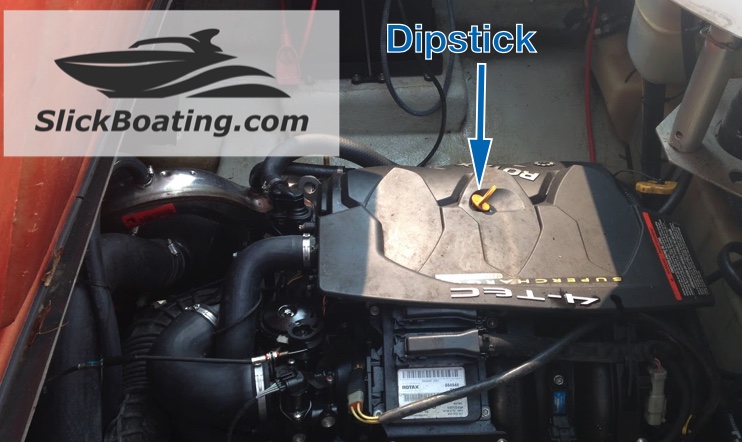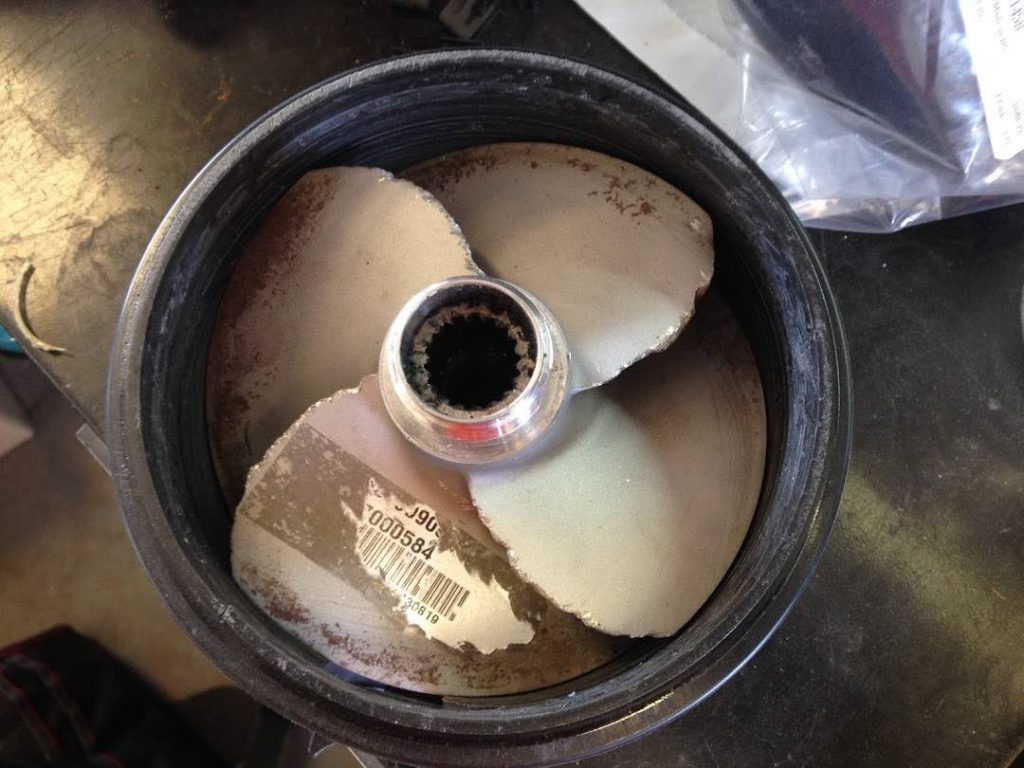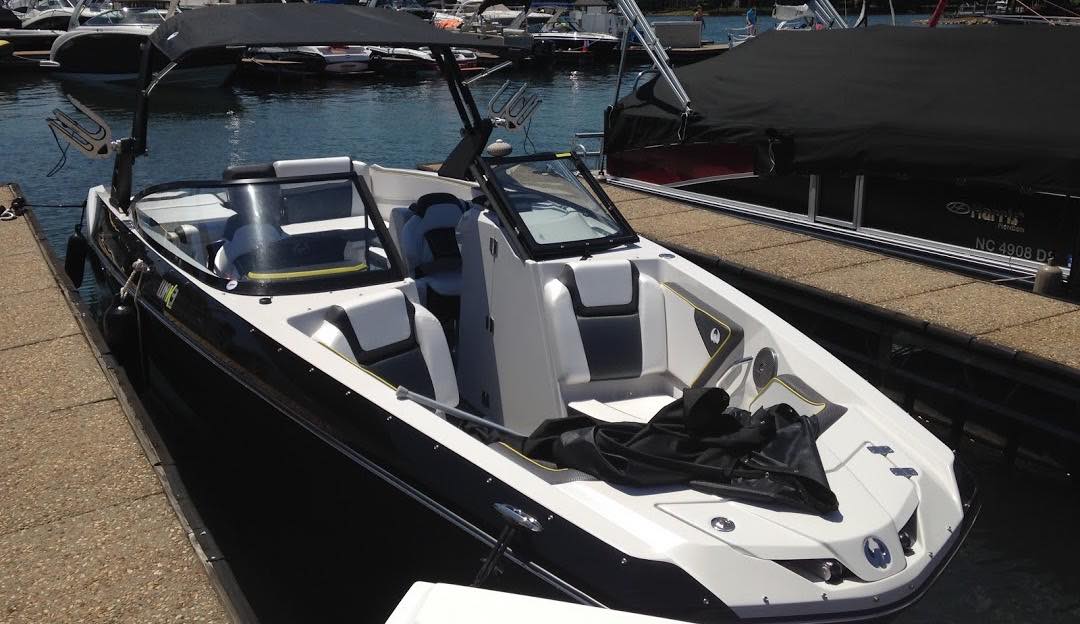Since a jet boat is not like a regular boat, you might be wondering what to look for when buying a used jet boat?
Through many years of working at a boat dealership, I’ve created a list of what I look out for when buying a used jet boat.
Some of my advice is a bit controversial, but real-world experiences help shape this point of view.
Note: If you ever bought or owned a jet ski, you’ll find many of the things to check are the same.
1. Avoid 2-Stroke Jet Boats
I 100% avoid 2-stroke jet boats.
It’s been over a decade since Yamaha or Sea-Doo made a Jet Boat. Scarab jet boats never made any 2-strokes.
Parts are almost impossible to find, and 2-strokes don’t last as long as the 4-strokes we have today.
Many lakes have outright banned 2-strokes because they pollute the water more and use a lot more gas. The day of 2-strokes is long gone and not worth the trouble.
It’s easy to determine if you have a 4-stroke, only a 4-stroke will have a dipstick.

2. Check The Pump
Jet boats often come with a trailer, so this makes it easy to check out a used jet boat.
Get the jet boat out of the water and on a trailer. Chock the wheels off so it doesn’t roll away and make sure the battery is off.
Get under the boat with a flashlight and look at the intake and jet pump. Here is what the intake and jet pump looks like.
You want to see if anything is out of the ordinary. You don’t want to see sticks, rope, fishing line, or something that is not apart of the boat.
You also want to check out the impeller and wear ring. If the impeller has jagged edges or the wear ring has deep and excessive groves, that can be a problem. You don’t want the impeller and wear ring to look like this image below.

Then look at the rear of the jet boat at the pump and reverse bucket. You want to make sure nothing is loose or hanging. Make sure there is no excess rust or corrosion.
Have someone in the boat slowly move the reverse bucket forwards and backward to make sure it moves fine. Also, have them rotate the steering wheel and watch the nozzles in the rear move. The reverse bucket may bounce or jump a bit, so be careful and don’t have your fingers anywhere near them. The steering nozzle should move very easily and fluidly.
3. Check for Damages Especially the Underside
Since you just checked the pump and still have the boat on the trailer, it’s a good time to check for any hull damages.
It’s normal for a boat to have some damage after being used for years. It’s the excessive damage that you should worry about.
Fiberglass can be repaired, and if it’s not fixed, it can spread.
It’s super important you check the underside of the boat for any damage. You want to see if any white fiberglass strands are sticking out. If you see exposed fiberglass, then it needs to be fixed. Exposed fiberglass under a boat will absorb water and expand, which will make the fiberglass damage worse.
Seeing exposed fiberglass above the water line should be fixed too to keep it from getting worse.
4. What Are Too Many Hours for a Jet Boat?
I’ve personally seen a 2-stroke jet boat with 1,000 hours on it; for a 2-stroke, that is a lot.
For most jetboats I start to get worried when they go over 500 hours.
The amount of hours you put on a boat is going to be higher than say something like a jet ski. Where a jet ski you’ll see people doing less than 30 hours a year, a boat you might see some going as high as 100 hours a year.
Average Hours A Year
On average, I see people put 50 hours on a jet boat a year.
Someone going over these hours is not always a huge deal. What matters more is how well they took care of the jet boat during those hours.
I might get more worried if someone doesn’t have enough hours on a boat. This could mean something was always wrong with it, and they never used it. It could also say they never serviced their jet boat in a timely manner. I like seeing people who service and winterize their jet boats at least once a year.
How Long Do Jet Boats Last?
To me, I don’t buy jet boats that are over 15 years old or have over 500 hours.
Once you start to get over 10 years, cosmetic parts are hard to find, and after 15 years, more critical parts like engine and pump are even harder to find. After 15 years, you’re often stuck buying used parts if you want to keep the boat running.
Keep in mind; this is mostly for sport jet boats. The old school or aluminum hull jet boats often can go for longer as they use engine parts similar to regular boats. Since the jet boat market is more saturated with Yamaha’s, Scarab’s, and Sea-Doo Sport Jet Boats, that is what I mostly focus on.
5. Water Test The Jet Boat
When you take out the jet boat, you want to listen to any odd sounds. Anything that is overly loud and not fluid sounding.
This video does a great job of showing us the usual sounds of a jet boat.
When you are water testing the jet boat, make sure to check the reverse and neutral. Jet boats don’t have a “true” neutral, so a very slight creep is normal. The jet boats you get today have options to adjust neutral with a push of a button. We talk about how this system gives you more control and why I find it easier to drive.
You’ll want to move the forward, neutral, and reverse lever slowly as many of them are also the throttle lever too, just like a regular boat.
Don’t forget to check all the gauges and switches. Some jet boats are super fancy and can have touch screens or ballast tanks, so make sure those work. I’ve even played with some jet boats that had a built-in heater, kind of gimmicky as they take forever to warm up.
The touch screens you see on some are well worth it, especially if you do any pull sports. Some jet boats have a setting to allow you to control take-offs speed for certain pull sports; you set how strong it will take off and what speed to cruise at. It’s well worth to check to see if the jet boat has these features and if they do make sure they work correctly.
Don’t forget to test the blowers on any boat before starting the engine. The blowers need to be run for a few minutes to remove any gas that may have built up in the engine compartment. It’s important the blowers are working properly before starting the boat. You’ll also want to turn the blowers on before you dock or turn the engine off. Consult the owners manual for proper blower procedures.
6. Check The Interior
Make sure the seats don’t have any tears in them.
Check under all the seats and storage compartments to make sure nothing is missing or damaged.
The steering wheel should move freely with the engine off, especially on a Sea-Doo, Scarab, and Yamaha jet boats.
If you have a bigger jet boat, something like a 24 foot or bigger, check to see if it has a toilet and sink. Yes, many of these bigger jet boats will have a toilet, but it’s not what you expect. It’s more of a bucket that you have to empty in the proper areas.
The sink will have a clean water tank, and its pump should work.
Check the center ski locker to make sure no water is sitting. Sometimes rainwater can get in there, but it should drain out into the hull.
7. Check Compression
Checking compression on any boat is not hard, but it’s not the easiest thing for someone who’s never done it before.
A compression test is the best thing you can do to make sure a jet boat engine is working properly.
You’ll want to make sure the compression is over 100 psi, and more importantly, the compression of all cylinders is close to each other.
If it’s a three-cylinder engine, you want to see something like 150 psi, 145 psi, and 155 psi. If you see something like 110 psi, 165 psi, 150 psi, then something is not right. Being way off from the other two is not a good sign.
As stated before, checking compression is not easy if you’ve never done it before. If you’re worried, it’s best to take it to the nearest repair shop and just have them do this check and many others for you.
8. Check Service Records Of The Jet Boat
I like seeing a jet boat owner who got their jet boat serviced at least once a year, and if it gets cold where they lived, they also winterized it once a year too.
It should not be hard to get these records, and if they don’t have them, the dealership they took it to should have a copy if they got them to service it.
If they can’t supply any of that, there are a few things you can do in the next sections.
9. Make Sure The Oil Is The Right Color
The biggest thing you can do is to check the color of the oil.
Pull out the dipstick and see what color it is.
- Black – It needs to be changed.
- Golden brown kind of see-through – It’s been changed very recently.
- Milkshake brown or runny – You got water in the engine. This is very bad.
Most often, the oil will be black. This is not always a good indicator that you need to change the oil, but if it’s not golden brown and they owner can’t supply proof of the last oil change, you may as well change it.
If the oil looks like a chocolate milkshake, you need to run away. They got water in their engines and it will be costly to fix everything.
10. Check For Rust On the Engine
If the boat lives near a saltwater source, then seeing some rust is normal.
It’s the excessive rust or paints chipping off the engine block that is a problem.
Too much rust can mean electrical connections are failing. If electrical connections are failing, then phantom problems start to happen. This only becomes a problem with excessive rust. You get excessive rust when the paint on the engine start to peel off. If you get to this point, I’m not a fan of the boat.
11. Check The Price To Make Sure You’re Getting A Good Deal
To figure out if you’re getting a good deal on your jet boat, you can check out NADA.
I also don’t stop there as I will check out craigslist or eBay to see what a similar model goes for.
Most often, the price of the trailer is included with every jet boat, so keep that in mind. It’s odd to find someone who buys a jet boat without the trailer.
12. Check The Trailer
Often overlooked, the trailer your jet boat sits on is super important.
You need to check the tires to make sure they’re not flat or dry rotting. Tires for trailers can often cost more than tires for your car.
The lights on the trailer need to be checked too. This can be tricky as I’ve seen people’s lights on their vehicles not working properly and confuse that for their trailer lights. You can buy trailer light testers to be sure the lights on the trailer work and it’s not something else.
And from personal experience, check for damages on the frame. I had one old jet boat that didn’t seem to sit right, and the nose kept going up. Come to find out the frame was cracking and bending due to it being rusted out.
Any cracks or damage on a trailer is a HUGE issue! There are no quick fixes for damages to the trailer’s frame. It must be done correctly, and it often means buying a new trailer.
Don’t forget to check if the safety chains are good and not damaged. The trailer latch needs to be looked at too. You want to make sure the trailer latches to your truck fine and won’t come off the ball. A loose latch is not good, but they’re super easy and cheap to replace. In fact, if the latch is over ten years old, I would think about a new one.
13. Check The Battery Of Your Boat
It seems the battery on boats is the most overlooked thing.
The great thing about boats is that they have on and off switches to help cut down on battery drain. But this is not perfect, and batteries will naturally drain if they’re not used.
You’ll want to start the boat in the water to make sure it’s strong enough to start it. The reason you check in the water as it creates a drag on the engine and lets you know for real if the battery is good or not.
If you’re in doubt, just replace the battery. They’re only made to last three years, and so many people neglect them that they often don’t last a year.
Pro Tip: Get a solar battery charger for your boat. When you’re not using the boat, have the solar charger somewhere that the sun can get to. Stick to around 5-watts for the solar charger, avoid going under that and avoid going over 20-watts. You just need the solar charger to keep the battery active and maintained.
14. Check To See If The Jet Boat Takes on Water When Running
I had a jet boat that would take on water only when the engine was running. The guy never noticed it because he always kept in on a lift, and when he did ride, the bilge pump was quick enough to pump it out.
When you do a test ride on the jet boat, find an empty spot in the middle of the water and lift open the engine compartment. There should be no more than a cup or two of water. If you see water in the engine bay, it’s best to get back to the trailer and get it on dry land.
Another thing I do when I check out a used jet boat is to put it on the trailer and pull up on to land. When on land, I like to pull out the drain plugs to see how much water comes out.
Some water coming out is normal, but if it’s pouring out more than a gallon of water, I start to worry, especially after riding it.
You’ll get rainwater that makes its way to the bottom of the boat after all a boat is a giant collection bucket. It’s when you have water coming out the drain plugs and it takes forever to drain, then you know you have a problem.
If the water is hot coming out of the drain plug, then it means it was near something warm like the engine or exhaust. Not a huge red flag as the engine compartment gets hot, but if there is a lot of warm water coming out of the drain plug, then I would worry.
15. Have The Jet Boat Inspected By A Dealership
If any of this scares you or you simply don’t know where to begin, the best thing you can do is let your local repair shop check the boat out for you.
A jet boat is not a cheap purchase, and getting a professional opinion could save you a lot of money.
I’m just some guy on the internet, so I don’t know the exact situation of the jet boat you’re looking at. You could describe it to me, but I’ll never be 100% in knowing all the issues. This is why the most critical step you can take is to take the boat to a dealership and let them run their test on it.
The dealerships have the computers to hook up to the boat to see things you can’t see. For all you know, the guy selling the jet boat could have done something to mess with the hours, but you can’t full the multiple internal computers, and the dealership’s computers can figure that out.
